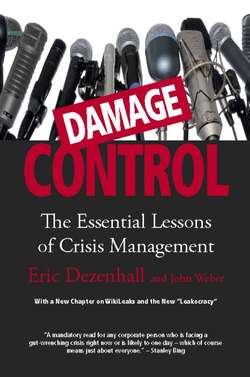Читать книгу Damage Control (Revised & Updated) - Eric Dezenhall - Страница 10
На сайте Литреса книга снята с продажи.
REAL DAMAGE CONTROL
ОглавлениеThe term “damage control” originated when the Navy had to grapple with a new technology—the torpedo—and its devastating impact on a vessel. Even if torpedoed, a vessel could sometimes recover and carry out its mission if the crew had the right skill set. Only in the recent media age has the term been applied to public relations and vulcanized to imply that a slick trick can undo the destruction of a metaphorical torpedo’s impact.
Wal-Mart, once the very symbol of heartland American success, is routinely framed as a cultural villain in the popular press. The once venerable Arthur Andersen accounting firm imploded in an ethics scandal and was vindicated only after declaring bankruptcy. The “blockbuster” drugs Vioxx and Celebrex were respectively recalled and fettered by terrifying safety claims. Dan Rather, the “Voice of God” of network television news for decades, was deposed in a scandal involving flawed sources and forged documents. The venerable Hewlett-Packard was rocked by a seemingly idiotic corporate spying scandal. Nothing escapes a torpedo.
Meanwhile, for every company that is vilified for mismanaging its affairs, another one resolves its problems with little fanfare: Tyco, which focused on internal audiences such as its customers, comes to mind, as does General Electric’s smooth transition between legendary chief Jack Welch and his successor, Jeff Immelt. For every conviction for corporate fraud (WorldCom’s Bernard Ebbers), there is a stunning acquittal (HealthSouth’s Richard Scrushy). What accounts for these different outcomes?
How was the same Martha Stewart who was shredded in the press for her clumsy handling of the public relations surrounding her criminal case eventually hailed as a genius upon her release from prison? Why does the admittedly inarticulate President George W. Bush enjoy communications victories that often overwhelm his adversaries? Meanwhile, war hero John F. Kerry finds his patriotism under attack in the 2004 election at the same time that Bush, who was thousands of miles from Vietnam during that war, is popularly linked to American military bravado.
And what are the differences between damage control for a big company and that for a high-profile individual? A hysterical celebrity who awakens his crisis manager at midnight often just wants to be told that he will still be adored regardless of his actual behavior. But a company needs to make money. Money can always be made discreetly, out of the limelight, while mass adoration inherently requires media coverage. The rules of damage control apply to Sunset Boulevard differently than they do to Wall Street.
Damage Control answers these and other questions from the perspective of world-weary crisis managers, not wishful-thinking academics. This is a no-holds-barred practical guide geared toward those who want to learn about the harsh realities of crisis management, not those who necessarily want to “make it” in the conventional public relations industry.
The mission of this book is to dispense with the dogma and impart the basic “facts of life” about modern crisis management—what works, what doesn’t, and why. These are basic lessons passed on by authors who have spent their careers managing the nastiest public relations battles imaginable.
This book reflects the way things really are, not how we wish them to be. Life-and-death public relations struggles are not about information, as the industry repeatedly preaches. They are about power.
We endorse a political model of crisis management versus the more conventional public relations approach. The fundamental difference is that the political model, which is practiced in our hometown of Washington, D.C., assumes the threat of motivated adversaries, while the public relations model tends to view crises as organic and resolvable through good communications. In real crises there are often opponents—a mirror image of your own crisis management team—that want to torpedo you. That opposing team consists of competitors, plaintiffs’ lawyers, the news media, politicians and regulators, short-sellers, multi-million-dollar nongovernmental organizations (NGOs), corporate stalkers, whistleblowers, and bloggers. These opponents don’t care whether you “do the right thing”; they care about defeating you.
